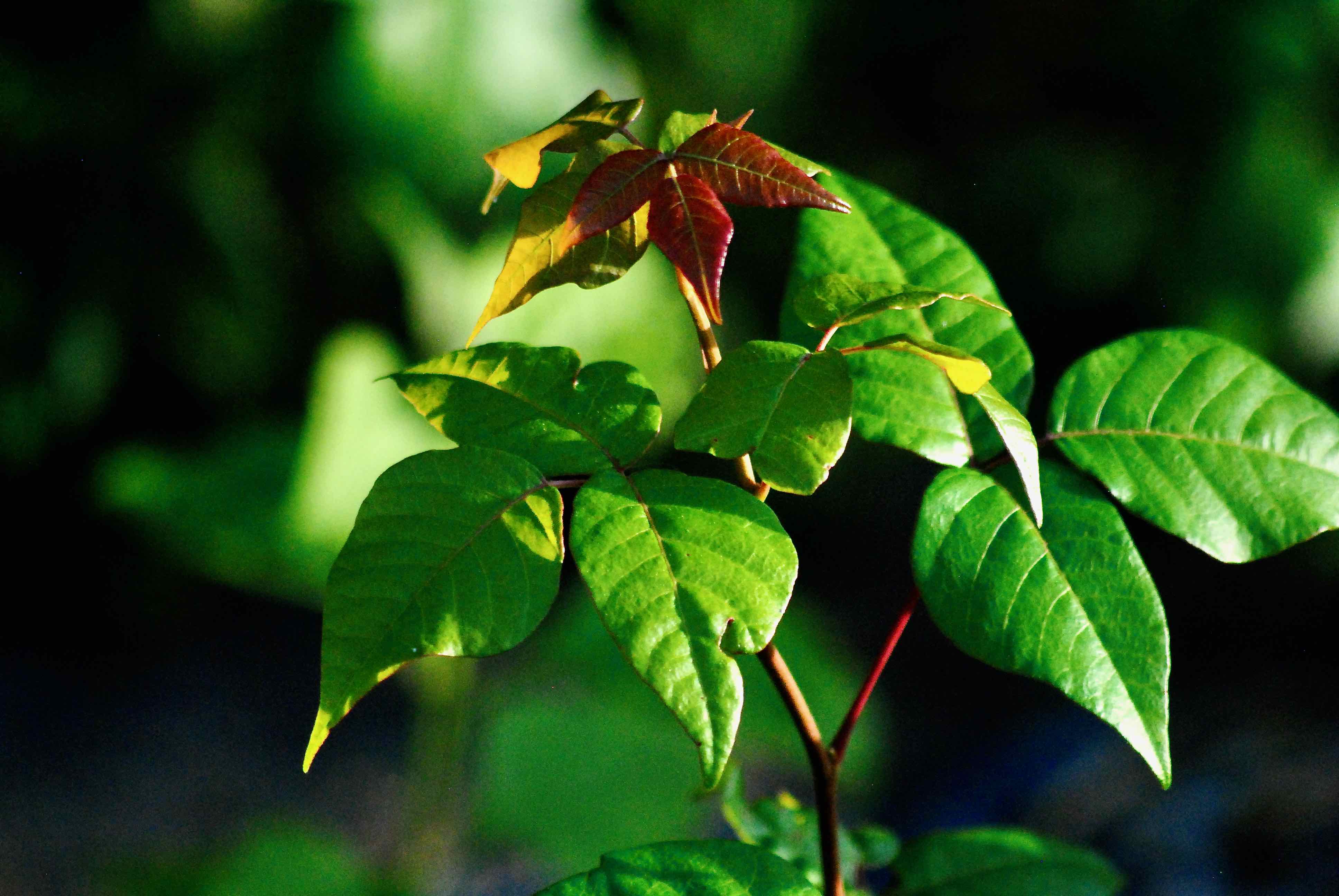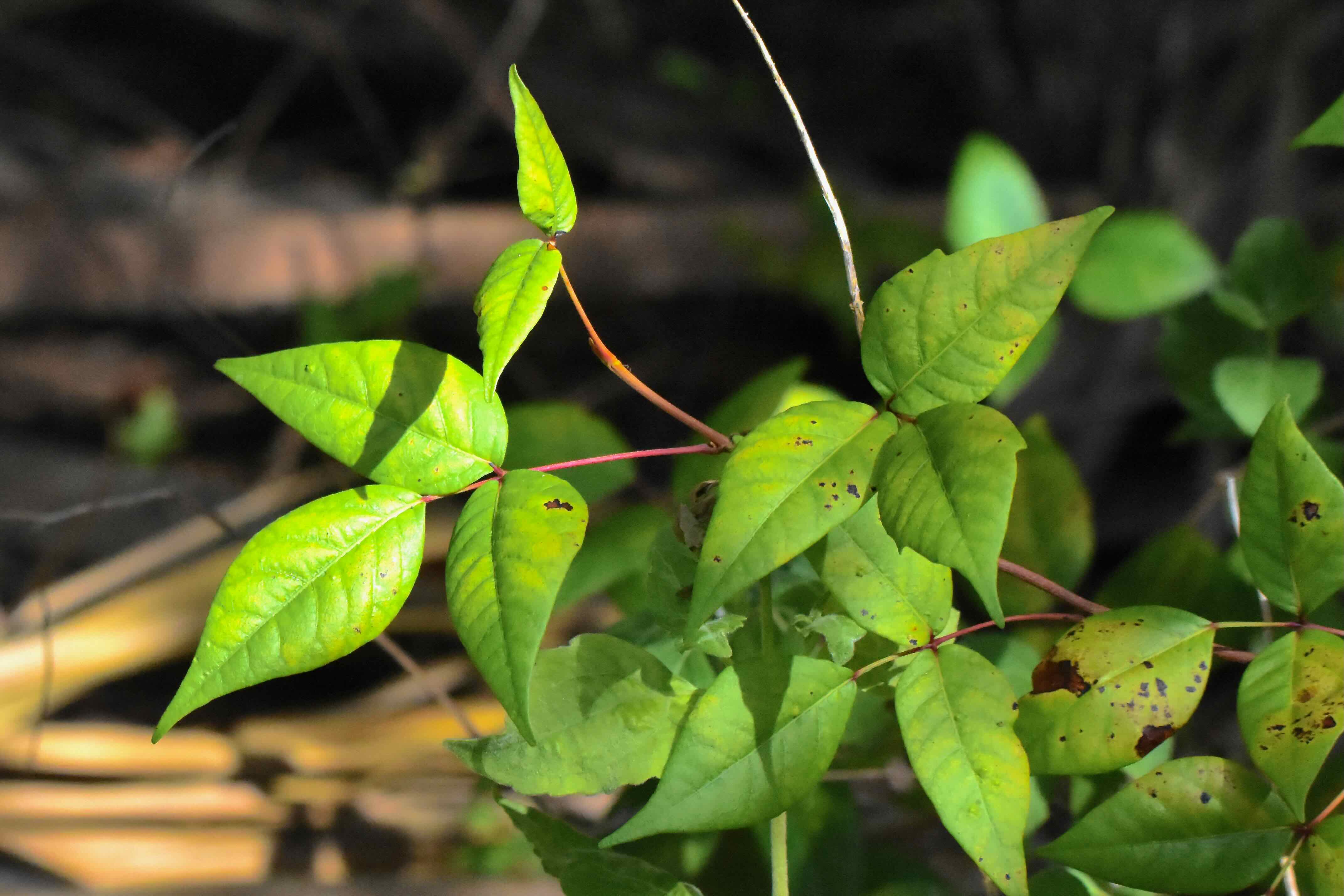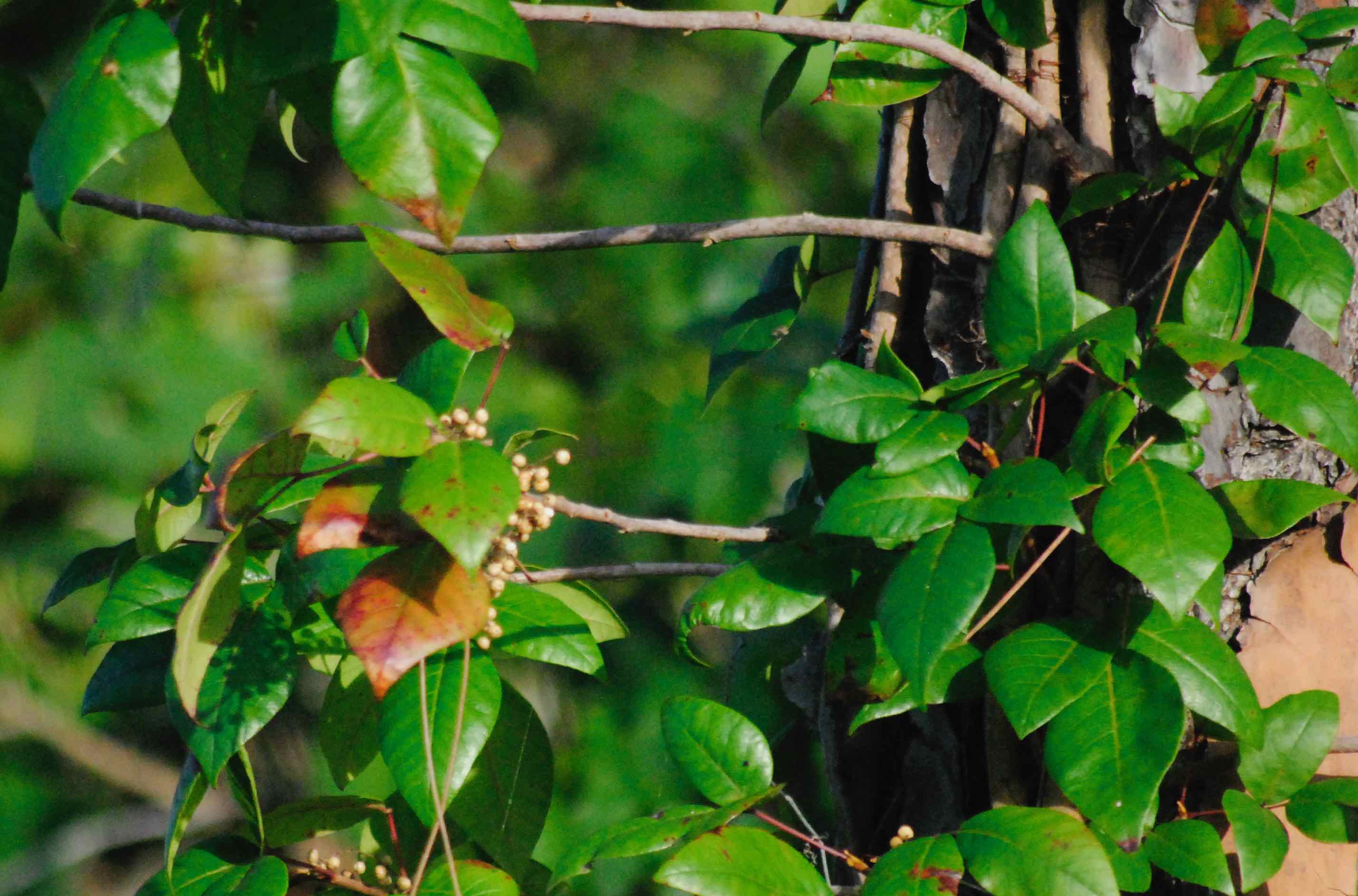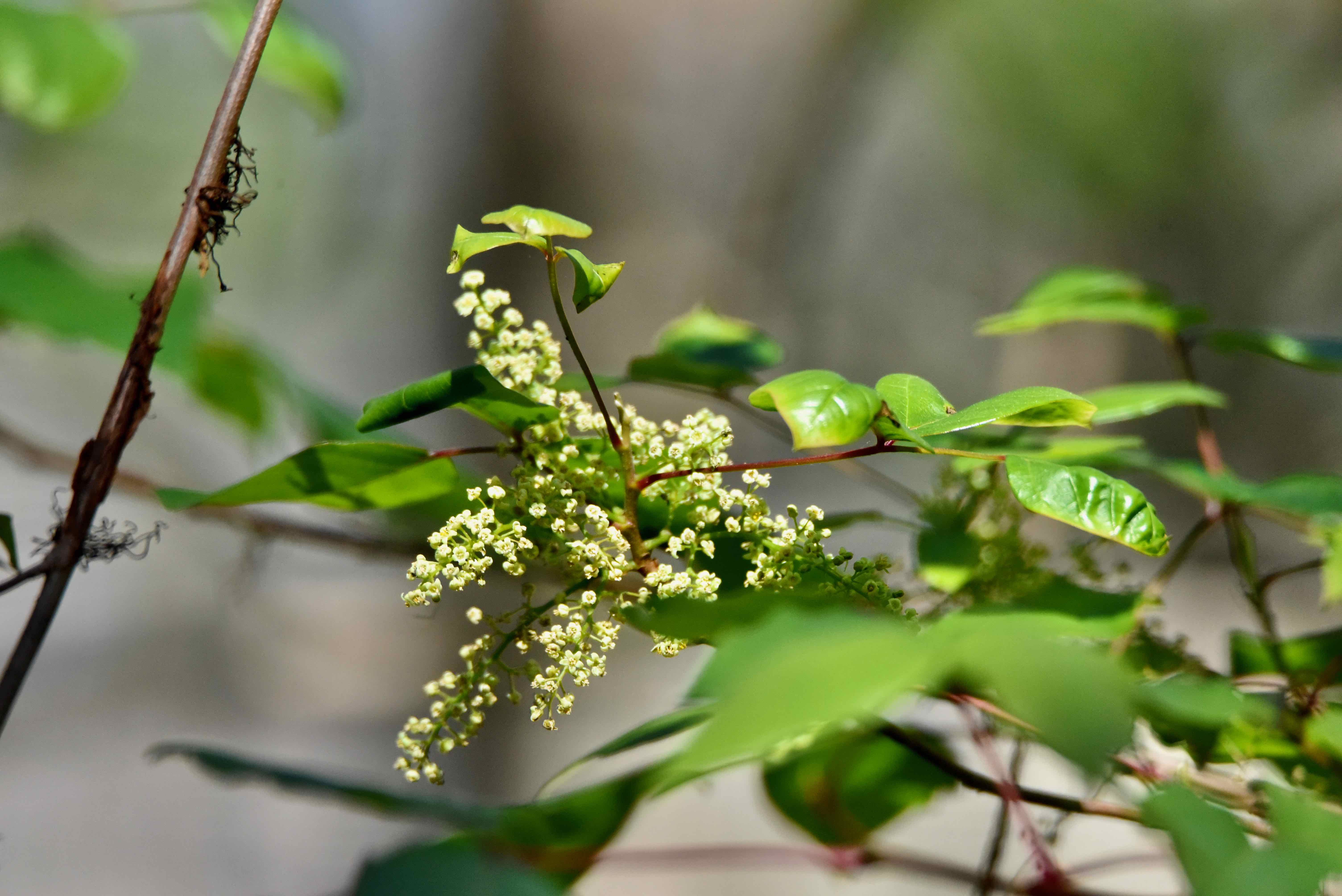
Leaflets of three ... Poison ivy, photographed at West Creek Natural Area, Coconut Creek, Broward County, in June 2014.
Say one thing about poison ivy, it's extremely adaptable. It grows up north; it grows down south. It thrives in the sun; it thrives in the shade. It grows as a shrub six feet tall, or as a vine 150 feet long, up a tree or along the ground.
And every inch of it skin-irritating, because of urushiol, the same oil found in poison oak, poison sumac and poisonwood. Oddly enough, it's only us humans and a few other primates that are susceptible to it.
The leaves of poison ivy are compound and irregular — their shapes and color can differ even on the same plant. But poison ivy always has three leaflets, the middle one on a stem longer than the first two. Leaflets of three, let it be. It's the one plant anyone who wanders in the woods has to know.
The leaves are arranged alternately along the stem, with leaflets two to eight inches long and one to six inches wide and usually pointed at the apex, or end. The edges (margins) can be serrated or lobed or smooth (entire in botany speak). Poison ivy is deciduous, meaning it drops its leaves come fall. However, in here in South Florida we’ve seen it “green” every month of the year. (It may produce new leaves as the old ones drop, or it may have a short period when it’s leafless. Or neither. Honestly, we don’t know.)
Poison ivy has clusters of nondescript greenish-white flowers that appear at leaf axils (the point where the leaf meets the stem); each flower has five petals and produces a white, waxy berry-like fruit. Birds eat them — it's actually an important source of food for some species — and the plant, leaves and all, is food for deer.
For us human types, the practical benefits of poison ivy are pretty much limited to — nothing. It's been used in folk medicine to treat osteoarthritis, but studies haven't confirmed its usefulness. It's been used to try to desensitize patients with urushiol allergies, but that's been discredited. It's also been used as a folk remedy for liver ailments. We've read that some eat small quantities of the leaves in order to build immunity to urushiol, but medical experts say taking poison ivy internally is a very bad idea, not to mention that “immunity” is impossible.
About 15 percent of the world’s population is resistant, not immune, to the itchy effects of urushiol; these people won’t develop a rash (aka contact dermatitis, aka Toxicodendron dermatitis) after exposure to poison ivy or one of its toxic cousins. In the 85 percent of the population that’s susceptible, the effects can range from mild to severe, but the degree of susceptibility can change within a person’s lifetime.
It’s only humans and a few other primate species that develop contact dermatitis from poison ivy. Your pet dog or cat can romp through the woods without a problem, but if they’ve come in contact with the feared leaflets of three, you might have a problem after handling Fido or Fifi.
Burning poison ivy won’t kill the plant, but the resulting smoke can cause a rash to develop among those exposed to it. Urushiol is so long-lasting, scientists who’ve touched the leaves of 100-year-old specimens have developed dermatitis.
Some people mistake Virginia creeper for poison ivy, but the resemblance really isn't close. Virginia creeper has five leaflets, and tendrils, which poison ivy lacks. Poison ivy's scientific name: Toxicodendron radicans.
Urushiol is so potent that a single nanogram of the oil is enough to cause a rash to break out on a human, according to the Poison Ivy, Oak, Sumac Information Center. A quarter-ounce is enough to give everyone on the planet a rash. It can remain active on a surface for as long as five years, even on a dead plant.
Oddly enough, people with certain immune deficiencies, including AIDS, are less likely to develop a rash from exposure to urushiol. On the other hand, reactions can be severe for those who are allergic to the oil — blisters can break out on the skin and eyes can swell shut. Soap and water can remove urushiol, like most other oils. However, urushiol tends to seep deep into the skin and bond in three to 30 minutes. It’s a major cause of workers comp claims among those who make their living in the great outdoors.

Back to the plant itself: It is a pioneer species, meaning it will be among the first species to make a home in a newly cleared area, from a fire, death of a tree or other disturbance. Poison ivy produces clusters of berries that turn white when ripen, seen in the first photo below, but they are nutritionally low quality. Up north in the fall, migrating birds will munch on better quality fruit, largely ignoring poison ivy. That leaves the berries available, and especially valuable, to species that winter over. All in all, 60 species of birds eat poison ivy.
Poison ivy can spread and form dense thickets via rhizomes that typically are four to six inches deep in the soil. The rhizomes also help poison ivy survive fire (it can also resprout from root crowns). Poison ivy can produce roots that tunnel down as deep as 12 feet.
It is a perennial, but exactly how long it can live is uncertain. One stem nearly five inches thick was cut open. Researchers found 38 growth rings, indicating a lifespan of nearly four decades.
Poison ivy is found in 61 of Florida’s 67 counties, according to the U.S. Department of Agriculture’s PLANTS Database. The exceptions: Hendry, Gadsden, Washington, Bay, Suwannee and Gilchrist. (The University of South Florida’s Atlas of Florida Plants has it in 66 of the 67 counties. Both USF and USDA use vouchered, or scientifically documented, specimens to determine a plant’s range in the wild. The USDA uses USF data, but the two often differ slightly.) It’s found throughout the eastern U.S. as far north as Maine and as far west as Texas. Poison ivy is also found in most of Canada.
Fun fact No. 1: Captain John Smith of Jamestown and Pocahontas fame coined the name, poison ivy. Smith also gave us opossum.
Said Smith: "The poisoned weed is much in shape like our English ivy, but being touched, causeth redness, itching, and lastly, blisters, and which, howsoever after a while pass away of them-selves, without further harm; yet because for the time they are somewhat painfill, it hath got itself an ill name, although questionless of no ill nature.”
Fun Fact No. 2: Minnesota has declared poison ivy to be a prohibited noxious weed. No kidding.
Fun Fact No. 3: Urushiol comes from a Japanese word meaning lacquer. When workers restored the gold leaf on Kinkaku-ji (Temple of the Golden Pavilion) in Kyoto in 1987, they used urushiol lacquer to preserve and maintain the gold. Yes, any thieves would have been caught red-handed.
Fun Fact No. 4: During the occupation of Japan after World War II, American soldiers developed rashes in some rather unusual places from toilet seats (and other furniture) coated with Japanese lacquer probably made from one of poison ivy’s urushiol-containing cousins. (Poison ivy is native to Japan, the Kurile Islands, Sakhalin, Russia, Taiwan and parts of China).
Fun fact No. 5: What grows in Florida and most of North America Texas eastward is called eastern poison ivy (also spelled poison-ivy). There is a western poison ivy, Toxicodendron rydbergii, found over much of the continent, including the Mid-Atlantic states and the Northeast. But not here. Thankfully.
Fun Fact No. 6: There are nine subspecies of poison ivy, not surprisingly given its vast range. The variety found in Florida is called T. radicans radicans.
Fun Fact No. 7: Poison ivy truly has become a cosmopolitan plant thanks to us humans. It’s found naturally throughout North America, Central America, the Caribbean and parts of far eastern Asia as mentioned above. Believe it or not, it’s been exported to Europe, Africa, Australia and New Zealand as an ornamental.
Poison ivy is a member of Anacardiacae, the sumac family, which includes mangoes, cashews and pistachios as well as poisonwood, poison oak and poison sumac.
West Creek Pineland Natural Area



